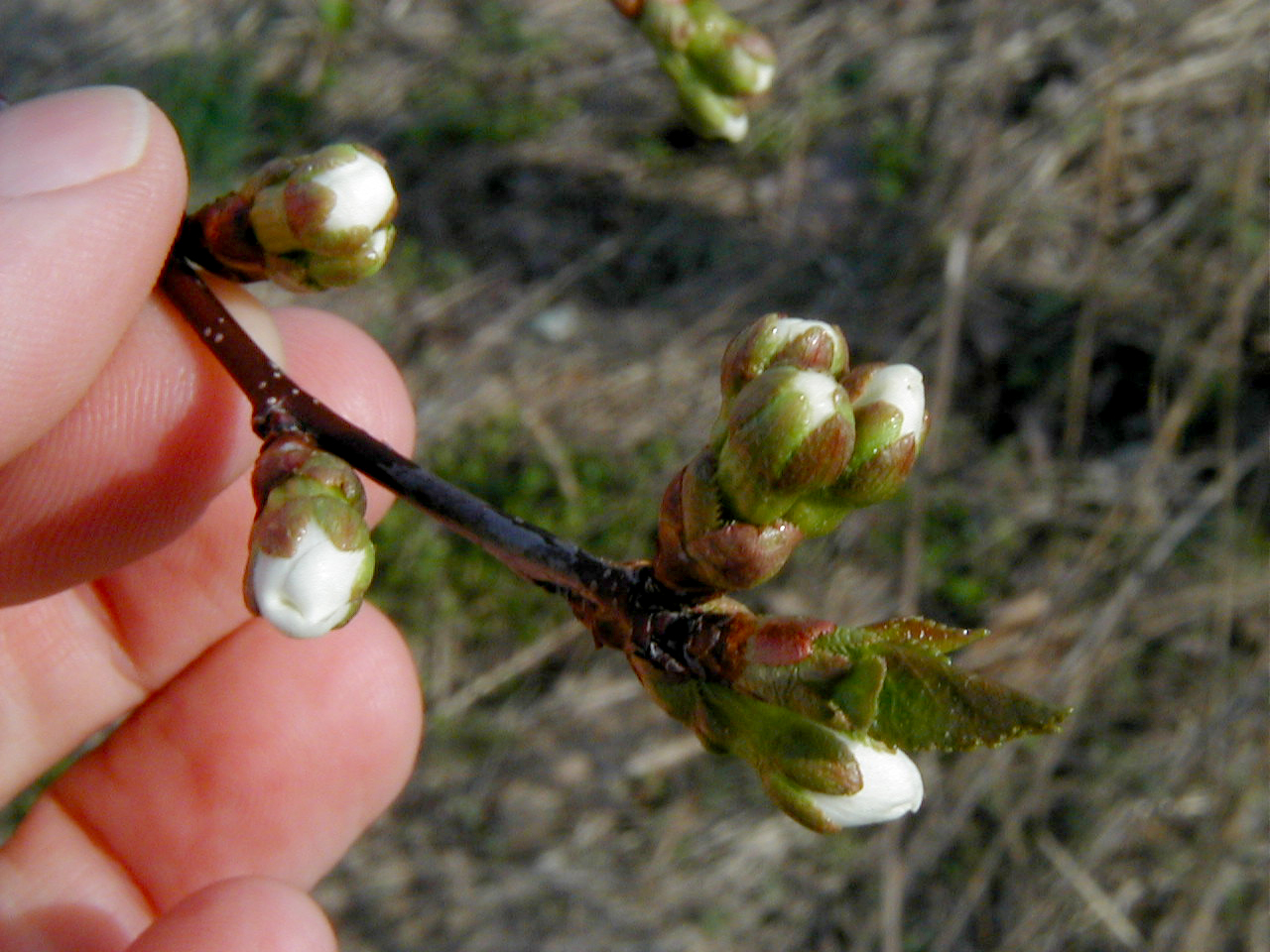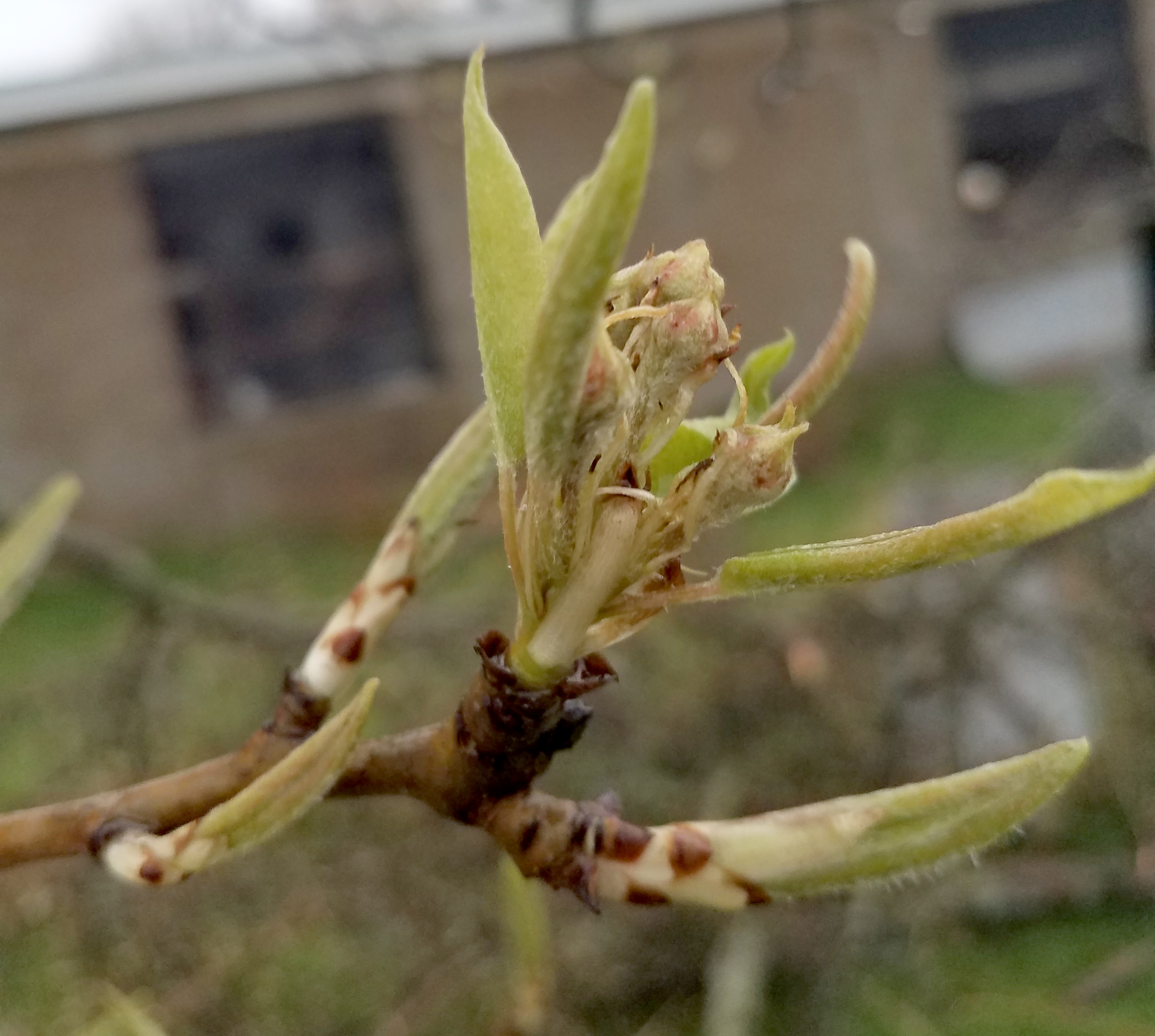Southwest Michigan fruit update – April 30, 2019
No damage occurred following the recent freeze and snow. Sweet cherries are blooming.

Weather
Last week cooled off. High temperatures began in the 70s and fell to the 50s by the weekend. A frost on Wednesday morning, April 24, caused little damage as the dew point was just below freezing. Even though we had frost, flowering trees and shrubs such as magnolias were not damaged.
Rain was spotty across the region. Rain turned to snow Saturday night, but Sunday was warm and sunny and the snow was gone by noon. Precipitation totals were about half an inch. Widespread rain across the region on Monday was an infection event for many diseases.
The forecast for this week is for rainy conditions as the storm track brings batches of rain into Thursday. Fields are soaked and there is standing water in many fields Monday afternoon. Friday and the weekend look to be dry.
We picked up about 66 growing degree days (GDD) base 42 and 32 GDD base 50, about the same as the week before. Judging by the bloom of apricots and sweet cherries, we are about three to four days behind their average bloom date well in the normal range. Soils are wet and soil temperatures are about 50 F. We are close to our normal heat accumulation (GDD).
|
Southwest Michigan GDD summary from March 1 – April 28, 2019 | |||
|---|---|---|---|
|
Station |
GDD 42 F |
GDD 45 F |
GDD 50 F |
|
Benton Harbor (SWMRC) |
243 |
179 |
101 |
|
Lawton (Lawton) |
248 |
182 |
101 |
|
Fennville (TNRC) |
196 |
142 |
76 |
|
Average for the SW region |
246 |
181 |
102 |
|
Accumulation last week |
66 |
52 |
32 |
Check out the new animated weather forecasts from Jeff Andresen, Michigan State University agricultural meteorologist, on MSU Extension’s Weather for Fruit & Nuts page. Articles and other regional reports can be found at the New for Fruit & Nuts page.
Tree fruit
Last week’s freeze did not harm flowering trees and shrubs, magnolias, flowering pears, forsythia, etc. As we move into bloom, temperatures below 30 F can damage flowers at bloom and developing fruit afterwards (see “Freeze damage depends on tree fruit stage of development”). Check blocks for evidence of San Jose scale on branches to determine the need for oil sprays, as that window is quickly closing.
Apricot bloom has ended. There was a light bloom of only a few varieties. We assume the lack of bloom was due to the loss of winter injury to flower buds.
Peach and nectarine leaves are expanding. There is very little bloom in peaches in southwest Michigan due to damage from the severe cold of the Polar Vortex in late January. It is strange to see no bloom in the peach orchards of Berrien County. This extreme cold was restricted to southern Michigan and did not affect tender stone fruit to the north where temperatures were warmer. Wood damage from January’s subzero temperatures will call for different pruning and fertilizing strategies (see “Cold damage to peaches”).
With little or no peach crop, using copper to suppress bacterial spot populations may not be needed with no fruit to protect. Traps for monitoring the first generation of oriental fruit moth and dispensers for mating disruption should be out. The Enviroweather Oriental Fruit Moth model predicts emergence about April 29. The model predicts male emergence at 175 GDD base 45 from April 1. Newly planted and one-year-old peach and nectarine trees should be protected against oriental fruit moth, which attack the shoot tips in the early spring.

Sweet cherry bloom began last Thursday, and most varieties were in full bloom over the weekend. In cool springs, we see a difference in bloom timing between different sweet cherry varieties, and we are seeing that this year. There are also some differences in bloom between sweet cherry varieties due to loss of fruit buds during the winter.
Tart cherries look good and there is no obvious winter injury. Montmorency tart cherries are at first white and we are seeing some early bloom. At this bud stage, cherries could be damaged by 26 to 28 F.
Japanese plums bloomed last week. Temperatures below 28 F would damage the flower buds. We are seeing differences in flower bud numbers similar to those in apricots and cherries. Growers with black knot in their orchards should prune out all black knot and dispose of the knots by burning. This is an important step in managing this disease. Ascospores of the black knot pathogen are released from knots from late April to early July, with the highest concentrations in May.
Apples are at tight cluster for most varieties. Zestar is at first pink. Temperatures below 28 F would damage apples. Newly planted apple varieties such as Gala and Fuji, which are highly susceptible to fire blight, can gain some protection against this disease with low rates of Apogee in the pink and petal fall periods. April 18 was the first apple scab infection of the year. The long wetting period on Monday was a serious apple scab infection period. We continue to catch relatively low numbers of scab ascospores.
Cedar apple rust spores are out as well. Early season insect pests such as redbanded leafroller and spotted tentiform leafminer numbers jumped with the warm temperatures.

Pears are at tight cluster and white bud. Pear psylla are out. Temperatures below 26 F would damage pears.
Small fruit
Grapes are moving. Concords are showing color and moving into late swell. At full swell, Concord grapes would be damaged by temperatures of 20 F. We are seeing swollen buds in many different hybrid varieties. Vinifera grapes were damaged by the winter cold. Growers are assessing their vines and cutting back their winter damaged vines. Grape flea beetle are out.
Blueberry flower buds have burst and flower buds are at tight cluster to early pink bud. Blueberries at pink bud can be damaged by temperatures below 25F. Leaves are unfolding. Monday’s rain was certainly a mummy berry shoot strike infection. Many growers were applying fungicides to suppress early season diseases.
.jpg)
Strawberry flower trusses are in the crown. Once the flower buds have emerged, they can be damaged by temperatures above 20 F. Growers are putting down straw.
Bramble buds have opened and leaves are unfolding. Lime sulfur treatments for anthracnose should be used at a reduced rate.
Upcoming meetings
Our next Monday fruit IPM meeting will be May 6 at 5 p.m. at Fruit Acres Farms, 2559 Friday Rd, Coloma, MI 49038. These meetings are free and open to all. We review the current conditions in fruit crops and discuss pest control options with growers. Two Michigan RUP applicator recertification credits are available at these meetings.
A Blueberry Pollination Meeting is planned for Thursday, May 23, from 1 – 5 p.m. at the Trevor Nichols Research Center in Fennville, Michigan. Registration details will be released soon.
Related articles
- Southwest Michigan fruit update – April 23, 2019
- 2019 Fruit insecticide registration update
- For information on the winter cold in January: Recent extreme cold events produced varied temperatures with varied results in Michigan’s viticulture areas
- For information on determining winter injury to peaches: Cold damage to peaches
- For information on spring freezes: What are radiation freezes?
- Using Enviro-weather’s regional overnight temperature report during cold events
- Freeze damage depends on tree fruit stage of development
- Bloom dates for southwest Michigan tree fruits
- Current honey bee and bumble bee stocking information
- How to use Enviro-weather’s apple scab tool
- SDHI fungicides for apple scab management
- Controlling black knot in Michigan
- Managing grapevine crown gall
- Changes in small fruit weed control registrations for 2019
- The rise of the mummy: Mummy berries in Michigan
- Managing mummy berry shoot strike infections
- Scouting and management of mummy berry in blueberries
- Using degree days to predict pest and crop development in blueberries



 Print
Print Email
Email




